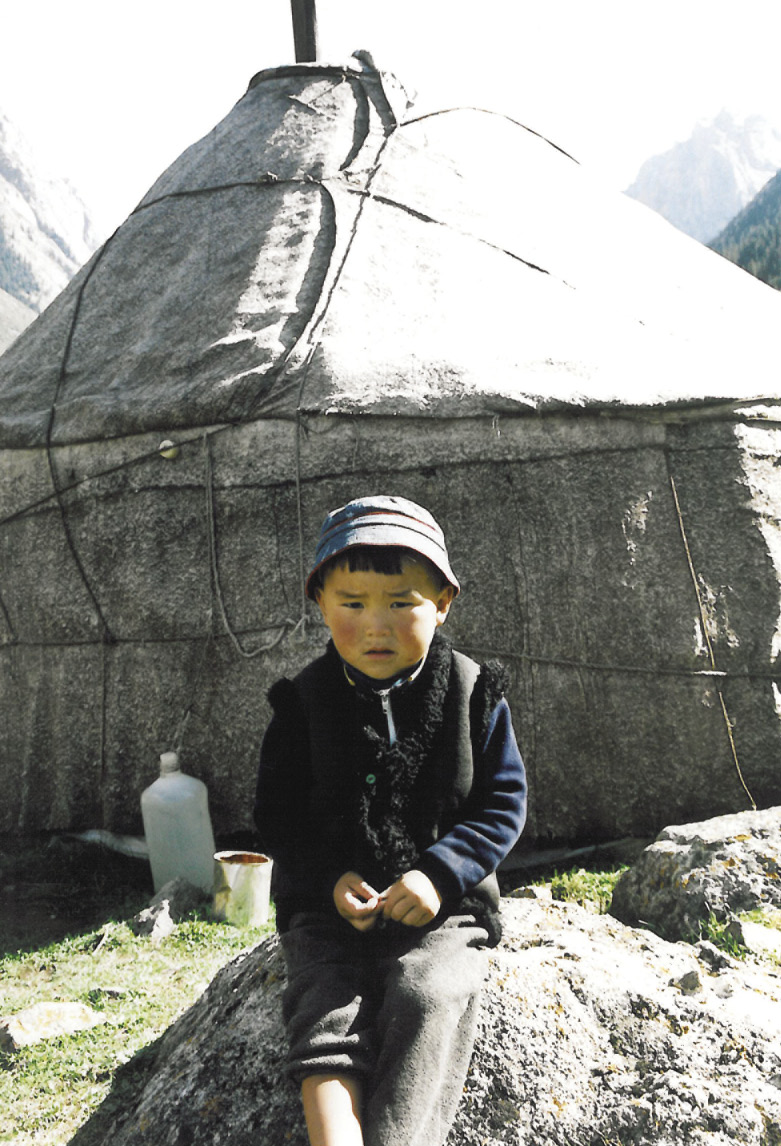- 1. Twin-bar tunes (ex.1-11, №1-58)
- Twin-bar tunes based on the g,-c bichord
- Twin-bar tunes based on rotating motifs
- Twin-bar tunes with descending/hill-shaped lines
- Motifs with a downward leap at the end of the line
- Motivic processes
- 2. Tunes moving on Ionian scales (ex.12-24, №59-164))
- Laments and their relatives
- Two-lined tunes of Major character with higher main cadences and their four-lined relatives
- Four-lined tunes of Major character
- 3. Aeolian tunes (ex.25-36, №165-238)
- Laments and related tunes
- Aeolian tunes with higher main cadence
- Four-lined tunes of Minor character
- Valley-shaped, ascending or undulating first line
- 4. Caramazan religious tunes (ex.37-41, №239-326)
- 5. Tunes of domed structure (ex.42-43, №327-332)
On earlier Kyrgyz folk music research in a nutshell
 Picture 5 Kyrgyz boy in front of their yurt
Picture 5 Kyrgyz boy in front of their yurt
Does it make any sense in our “modern” age to embark on such seemingly unnecessary things as Kyrgyz folk music? Hasn’t everything been said about this theme yet?
A. Pfennig already published several notated tunes in 1889 in his study entitled “O kirgizskikh i sartskikh narodnyk pesniakh”. Lach’s volume (1952) of songs recorded from WW1 POW’s including Kyrgyz people is also significant.
Zataevich (1934) presented a relatively large and reliable material including laments, epic fragments, Caramazan songs, love songs, plaintive songs, etc. and many pieces with fantasy names. Though the dynamic signs, among other things, suggest that the informants were not from among the simple people, the material is undoubtedly valuable. It is not a negligible problem, however, that Russian Zataevich did not speak Kyrgyz, so few tunes have their lyrics. In the evluation of isometric tunes this is not an unsurmountable problem but the majority of Kyrgyz folksongs do not belong to this category. Another good review of Kyrgyz folk music beside Azeri, Turkmen and Kazakh music is given by the works of Beliaev (1962, 1975) but there are only twenty folk examples.
From among the most recent works special mention must be made of Duşaliev’s and Luzanova’s (1999) jointly written book introducing the traditional Kyrgyz musical culture. They discuss vocal pieces, instrumental and epic genres and introduce the best known performers of the genres. Though the book includes some musical analyses, the classification and thorough comparative analysis of the tunes are not carried out. The notation of 48 songs and 13 instrumental tunes are given in the book.
For further Kyrgyz bibliography, see those in Beliaev (1939, 1952, 1954, 1962), Duşaliev and Luzanova (1999:238-245), Emsheimer (1943:34-63), Slobin (1969a, 2005), Waterman, R. et al. (1950:100-18) and Lach (1952).
In this light the 426 tunes selected from among the 1500 I recorded, transcribed and analyzed is a significant corpus, particularly since my work is pioneering for its in-depth musical analysis, systematization and comparison with other folk musics.

